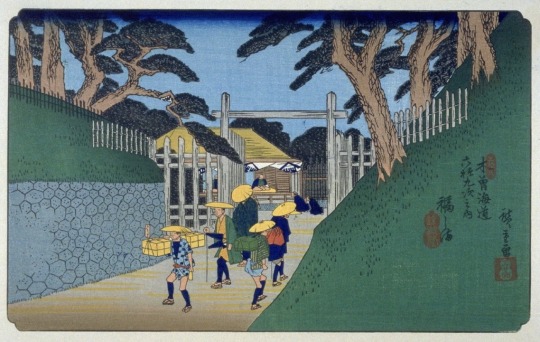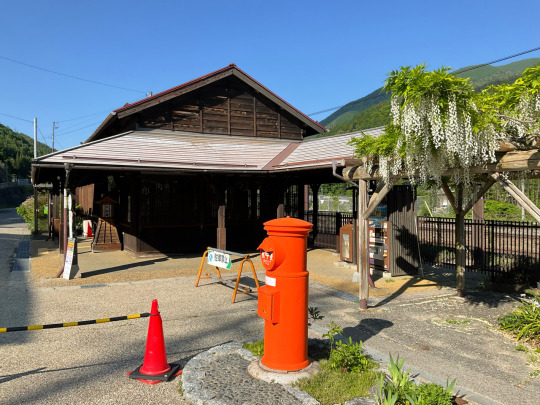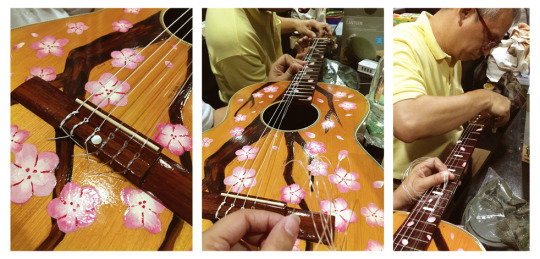#Kiso-Fukushima
Explore tagged Tumblr posts
Video
20240518 Kiso-Fukushima 7 by Bong Grit Via Flickr: 止め石一つ。 Photo taken at Kiso-Fukushima area, Kiso town, Kiso district, Nagano pref.
#school#Myousinji party#Myousinji group#Kiso-Fukushima#Kiso town#Kiso district#Nagano#Japan#Nikon#Nikon Df#COSINA#COSINA Voigtländer COLOR-SKOPAR 28mm F2.8 SL2 N Aspherical#flickr
10 notes
·
View notes
Photo

Fukushima, from Sixty-nine Stations of the Kiso Kaidō, by Utagawa Hiroshige, 1834-1842, Japan
66 notes
·
View notes
Text

Utagawa Hiroshige
Fukushima, pl. 38 from a facsimile edition of Sixty-nine Stations of the Kiso Highway (Kisokaido rokujukyu tsui)
20th century
#utagawa hiroshige#japanese prints#japanese art#japanese artist#asian art#woodcut#woodblock print#landscape#landscape aesthetic#japanese landscape#aesthetic#beauty#nature#modern art#art history#aesthetictumblr#tumblraesthetic#tumblrpic#tumblrpictures#tumblr art#tumblrstyle#artists on tumblr
7 notes
·
View notes
Text
Annex opened at "Onjuku Tsutaya" on Nakasendo Road. Overnight stay style with no meal, including use of a large public bath
In January, Tsutaya Honten opened an annex, ANNEX HATAGO (5139 Fukushima, Kiso-cho, Kiso-gun, Nagano Prefecture), across the street from the main “Kaido Roman Onjuku Tsutaya” building. All eight rooms are Western-style (four twin-bed rooms and four double-bed rooms), and unlike the main building, this is an overnight stay with no meals. Guests can use the main building’s large public baths…
0 notes
Text









I visited Narai-juku in Nagano prefecture where is famous for preserved traditional houses.
https://www.japan.travel/en/spot/1366/
129 notes
·
View notes
Photo

Thomas Struth - Sonnenaufgang in den Bergen bei Kiso-Fukushima, Japan, 1987
Tirage Cibachrome (30.5 x 40.5 cm)
13 notes
·
View notes
Video
kisofuku19 by amenohitravels Kiso Fukushima historic quarter amenohitravels.com/japan/kiso-fukushima/
21 notes
·
View notes
Photo

FOTO SHASHIN - July 2, 2019 - Hosta on the grounds of the Komanoyu Ryokan. Near Kiso-Fukushima, Japan. Postas as shot, no edit.
by HikerEyes
#hosta#flower#art#pink#droplets#water#rain#konanoyu ryokan#ryokan#japan#japan photos#nakasendo trail#no edit
4 notes
·
View notes
Text
Project Sakura
Last February was my birthday, and aside from the awesome birthday concert surprise (super super thank you and love you to my family, mom and dad <3) we got to go to a musical instrument surplus someplace around Sucat. There were dozens of second hand classical guitars, electric ones, bass guitars, drum parts, keyboards and accessories that were still functional or can still be repaired and refurbished, and was sold at a low price. So, with parents, we bought a nice electric guitar, electric bass, and this very simple classical guitar that I decided to paint on.

A rundown: (1) after sand paper-ing; (2) completed painting; (3) with varnish/finished product
The guitar is a Kiso Suzuki Guitar, originally made from Japan. Its origin instantly inspired me to paint it with a Japanese theme, thus the cherry blossoms or Sakura (and yes, the guitar’s name is Sakura). I also considered The Great Wave off Kanagawa, but I think the cherry blossoms were a better fit to it.

Before starting, I removed the strings, and my dad had to remove the tuning pegs. To paint on the guitar, we had to sandpaper the surface first so we could remove the varnish. Next is the outlining of the branches. I asked my lil sister, @tumbke to help me with drawing (’cause let’s face it, I suck at drawing haha!) and later on, with painting. We started to paint the branches, and then we let it dry.
After it’s dry, we then painted several solid white flowers of different sizes so that the pink color for the petals would be visible when we paint it on the guitar.
The next part was the hardest part, and that was to paint the petals and the details. We had to practice a lot on a piece of paper so that we could get the (at least nearly) perfect stroke for the petals, but at the end, we didn’t really get that one way of doing it so that it would all look the same. BUT, we did discover that by adding small details like the three dots at the middle and lines that would make the petals more prominent, they would eventually all look the same. We also painted petals on the neck part so it’ll look continuous.

Random photos of @tumbke painting the petals pink.
After everything was dry, we head on to varnishing the guitar. I didn’t varnish the sides and the back because I didn’t change anything on it, and we didn’t even sandpaper it. Then we let it dry too.
The last step was to put the tuning pegs back, and put new strings on it. I just realized that nylon strings don’t have that end stopper unlike those of steel strings, so you have to tie the other end on the bridge part. Asked dad’s help on tying them because I didn’t initially knew how to tie them in properly (learned something new! :D)

AND FINALLY! Project Sakura is finished!!! Special thanks to my dad, mom and lil sis for helping me finish it!

I’ve been testing it lately and i’m loving its sound! It’s more for plucking and fingerstyle-ing because the bass always stands out when strumming, and it’s very easy to get out of tune so I tune it every now and then. But overall yes. I love it. I don’t even care if it doesn’t have a pick up (I’ll use the detachable one so we don’t have to make a hole on the guitar to put a built in one), I love it.
So here’s a little test video. The song is “What I Really Wanna Say” by Nicole Serrano. Enjoy watching and thanks for getting this far! :D -T
youtube
#guitar#customize#japanese#1960#fukushima#sakura#cherry blossoms#paint#art#music#suzuki#kiso#project#refurnish
1 note
·
View note
Photo

#Travel Tokyo Japan Travel Attractions Destinations Map: Kiso Fukushima Station https://t.co/W0WN8qS81T #Tokyo #Japan https://t.co/yXezCwxMhI
#Travel#Vacation#Wanderlust#Destinations#Attractions#Adventure#Holiday#Trip#Asia#Bangkok#Bali#Singapo
0 notes
Video
20240518 Kiso-Fukushima 4 by Bong Grit Via Flickr: 山村代官屋敷の飾り。 Photo taken at Kiso-Fukushima area, Kiso town, Kiso district, Nagano pref.
#Decoration#Old#Chrysanthemum#Yamamura Daikan's residence#Japanese house#Residence#Japanese room#Kiso-Fukushima#Kiso town#Kiso district#Nagano#Japan#Nikon#Nikon Df#COSINA#COSINA Voigtländer COLOR-SKOPAR 28mm F2.8 SL2 N Aspherical#flickr
4 notes
·
View notes
Photo

No filter!! Art installation in a traditional Japanese house in Kiso. 木曽でのアートインスタレーション。 💎💎💎 ++BLOG UP++ A great milestone and dip into local communities. 足は良くなった!結婚記念日のサプライズもあって素晴らしい一日。 http://www.salz-tokyo.com/nakasendo-day-12/ (at Kiso-Fukushima Station)
2 notes
·
View notes
Photo

Ice Pillar in Kiso-Fukushima Nagano #Japan #nature #landscape #river #Lake #mountain #forest #flower #sunset #sunrise #Spring #Summer #Autumn #Winter #Autumn leaves
#lake#mountain#winter#landscape#sunset#spring#summer#sunrise#japan#forest#nature#flower#autumn#river
4 notes
·
View notes
Text
Discovering Japan - Gokaido, la strada per Edo
Tutte le strade portano a Roma si dice qui da noi, ricordando l'efficienza e la vastità dello sviluppo stradale in epoca romana; di certo il Giappone antico non reggerebbe il confronto, eppure anche nel passato del Sol Levante troviamo strade importanti. Cinque, per la precisione.
Se siete appassionati di escursioni o volete avventurarvi per itinerari meno battuti rispetto alle mete giapponesi più famose, prendete carta e penna e segnatevi questi nomi, non ve ne pentirete!
Pronti? Partiamo!
Disclaimer: le immagine sono tutte prese da internet e dei rispettivi proprietari.
Discovering Japan - Gokaido, la strada per Edo
Innanzitutto un po’ di storia: Edo era l'antico nome dell'odierna Tokyo e significava “estuario”, o anche “ingresso della baia”; dapprima piccolo villaggio e poi centro militare, divenne la più grande città del Giappone sotto lo shogunato di Tokugawa Ieyasu. Questo periodo storico prende il nome di “periodo Tokugawa” o “periodo Edo” (1603 - 1868).

Anche se si dovette aspettare il 1867 affinché Edo divenisse la capitale ufficiale con il nuovo nome di Tokyo (“capitale orientale”), rappresentava comunque il cuore del Paese e la potenza militare. Una volta assunto il controllo del Giappone, Tokugawa iniziò la costruzione del Gokaido (五街道, “le cinque strade”), un sistema viario che gli permetteva di tenere sotto controllo tutto il territorio grazie alle numerose stazioni di posta. Il punto di partenza delle strade era Nihonbashi, oggi quartiere commerciale di Tokyo.

Vediamo assieme queste famigerate strade una per una!
1) Tokaido (東海道, “via del mar orientale”), 488 km.

La più famosa e trafficata dell'epoca, la Tokaido si estendeva lungo la costa e arrivava fino a Kyoto. I viaggiatori andavano a piedi o si facevano trasportare in una portantina chiamata “kago” (non ridete) e le donne non potevano viaggiare da sole. Come accennato prima, c'erano delle stazioni di posta su tutta la rete e la Tokaido ne contava cinquantatré: qui i viaggiatori potevano mangiare, comprare provviste e riposarsi durante il viaggio. Vi erano poi anche le stazioni di controllo, dove si doveva esibire il permesso di viaggio per poter proseguire. L'opera più famosa che riguarda questa strada è la raccolta di illustrazioni del maestro di ukiyo-e Hiroshige, “le cinquantatré stazioni della Tokaido”.

Oggigiorno rimane la strada più trafficata del Giappone e da il nome alla linea shinkansen che va da Tokyo a Shin-Osaka.
2) Nakasendo (中山道, “la via in mezzo alle montagne”), 534 km.

Meno battuta rispetto alla prima e con ben sessantanove stazioni, condivideva con essa il punto di arrivo (Kyoto), passando però per le montagne. La Tokaido era più veloce, ma si dovevano attraversare diversi fiumi ed era più pericolosa, perciò si preferiva la Nakasendo per far viaggiare donne e bambini.
Ad oggi è uno degli itinerari più amati dagli escursionisti, grazie alla bellezza della natura circostante e dei villaggi tradizionali che si attraversano; la zona più bella è quella della valle di Kiso, famosa anche per il cibo. Qui si possono poi visitare alcune antiche stazioni di posta come Magome e Tsumago.

3) Koshu Kaido (甲州街道, “la via del Koshu”), 225 km.

Koshu era il vecchio nome dell'odierna prefettura di Yamanashi; questa via era stata voluta da Tokugawa come eventuale via di fuga in caso di un attacco nemico. Avete presente Shinjuku, la città che non dorme mai? Ebbene, i kanji che ne compongono il nome significano “nuova locanda”: era infatti la prima stazione di posta che si poteva incontrare lungo la Koshu Kaido dopo aver lasciato Nihonbashi. Qui vivevano le guardie di Tokugawa che avevano il compito di aiutarlo nella fuga in caso di pericolo. Dopo le sue quarantaquattro stazioni, la Koshu Kaido si congiungeva con la Nakasendo nella prefettura di Nagano. Oggi corrisponde alla strada nazionale numero 20.
4) Oshu Kaido (奥州街道, “la via dell'Oshu”), 183 km.

Anche Oshu era l'antico nome di una prefettura, precisamente quella di Fukushima. Unica tra le vie della Gokaido a portare verso Nord, la Oshu Kaido era attraversata principalmente da magistrati e daimyo del Tohoku che si spostavano per il sankin kotai, o “presenza alternata”: per ordine dello shogun, i signori feudali dovevano costruire una casa nella capitale e abitarci un anno, per poi tornare nelle proprie terre per un altro anno mentre i loro famigliari rimanevano a Edo. Un modo molto efficace per controllare i proprio sudditi! Con lo sviluppo della parte a Nord del Giappone e l'apertura al commercio con la Russia, la via divenne più trafficata e divenne quella che oggi corrisponde alla strada nazionale numero 4. Vi sorgevano ventisette stazioni.
5) Nikko Kaido (日光街道, “la via di Nikko”), 146 km.

Con le sue ventuno stazioni, di cui diciassette in comune con la Oshu Kaido, la Nikko Kaido era la più corta tra le cinque strade; fu voluta da Tokugawa per arrivare più facilmente al Santuario, ancora oggi uno dei più belli e famosi in tutto il Giappone. La Nikko Kaido è percorribile ancora oggi, magari partendo dalla città di Utsunomiya, prefettura di Tochigi.
E con questo per oggi è tutto, miei cari lettori! Vi chiedo scusa per la lunga attesa (dovuta ad impegni di lavoro e problemi di salute), vi prometto di organizzarmi meglio per scrivere più spesso.
Alla prossima!
#discovering#japan#tokyo#tokugawa#ieyasu#edo#shogun#daimyo#gokaido#tokido#nakasen#koshu#kaido#oshu#nikko#santuario#giappone#hiroshige#ukiyoe#ukiyo e#escursioni#itinerari#cinque#strade#vie#roma
1 note
·
View note
Video
Kiso Fukushima, Nagano prefecture, Japan by amenohitravels Via Flickr: Kiso Fukushima historic quarter amenohitravels.com/japan/kiso-fukushima/
0 notes
Video
vimeo
【 ICECANDLE FESTA in KISO FUKUSHIMA NAGANO (Z CAM E2C TEST)】 ICECANDLE FESTA in KISO FUKUSHIMA NAGANO (Z CAM E2C TEST)On February 7, 2020, Japan shot Z CAM E2C at the Ice Candle Festival in Kiso Fukushima, Nagano Prefecture. This time it will be an image that only adjusts the LUT and saturation. No noise reduction is used. 2020年2月7日、日本は長野県木曽福島にておこなわれたアイスキャンドルフェスティバルの様子をZ CAM E2Cにて撮影。 今回はLUTと彩度を調整したのみの映像になります。ノイズリダクションなどは使用してません。 ■Details ・Shooting information / C4K Zlog 24P ProRes422 ・camera / Z CAM E2C ・Lens / EF16-35mm F4L IS USM / EF70-200mm F4L IS II USM ・Lens mount / VILTROX EF-M2Ⅱ ・Filter / Cokin 82mm NUANCES Variable ND Filter ・Drive / G-Technology(HGST) G-DRIVE mobile SSD R-Series 500GB ・Monitor / Atomos Shinobi 5.2" 4K HDMI Monitor ・Rig / SmallRig ・Gimbal / DJI Ronin-S
0 notes

